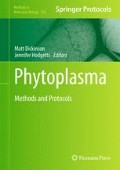Abstract
Insect vectors of phytoplasmas are limited to leafhoppers, planthoppers, and psyllids. While populations can be monitored by a number of passive techniques in the field, the capture of live insects is necessary for manipulation and study. A number of physical methods for capturing these insects already exist, but more innovative traps equipped with infochemical lures for species-specific monitoring and mass trapping are being developed.
Access this chapter
Tax calculation will be finalised at checkout
Purchases are for personal use only
References
Weintraub PG, Beanland L (2006) Insect vectors of phytoplasmas. Annu Rev Entomol 51:91–111
Vega FE et al (1993) Detection of a plant pathogen in a nonvector insect species by the polymerase chain reaction. Phytopathology 83:621–624
Maixner M (1993) Scaphoideus titanus, a possible vector of grapevine yellows in New York. Plant Dis 77:408–413
Jarausch B, Jarausch W (2010) Psyllid vectors and their control. In: Weintraub PG, Jones P (eds) Phytoplasmas: genomes, plant hosts and vectors. CAB International Oxfordshire, Wallingford, UK, pp 250–271
Carraro L et al (2004) Macropsis mendax as a vector of elm yellows phytoplasma of Ulmus species. Plant Pathol 53:90–95
Pilkington LJ et al (2004) Reducing the immigration of suspected leafhopper vectors and severity of Australian lucerne yellows disease. Aust J Exp Agric 44:983–992
Rice Mahr SE, Wyman JA, Chapman RK (1993) Variability in aster yellows infectivity of local populations of the aster leafhopper (Homoptera: Cicadellidae) in Wisconsin. J Econ Entomol 86:1522–1526
Weintraub PG, Horowitz AR (1996) Spatial and diel activity of the pea leaf miner (Diptera: Agromyzidae) in potatoes, Solanum tuberosum. Environ Entomol 25:722–726
Irwin ME et al (2000) Diversity and movement patterns of leaf beetles (Coleoptera: Chrysomelidae) and leafhoppers (Homoptera: Cicadellidae) in a heterogeneous tropical landscape: implications for redressing the integrated pest management paradigm. In: Ekbom B, Irwin ME, Robert Y (eds) Interchanges of insects between agricultural and surrounding landscapes. Kluwer, Dordrecht, The Netherlands, pp 141–168
Sharon R et al (2005) Vitex agnus-castus is a preferred host plant for Hyalesthes obsoletus. J Chem Ecol 31:1051–1063
Gross J, Mekonen N (2005) Plant odours influence the host finding behaviour of apple psyllids (Cacopsylla picta; C. melanoneura). IOBC/WPRS Bull 28(7):351–355
Mayer CJ, Vilcinskas A, Gross J (2008) Pathogen-induced release of plant allomone manipulates vector insect behavior. J Chem Ecol 34:1518–1522
Mayer CJ et al (2009) Cacopsylla melanoneura has no relevance as vector of apple proliferation in Germany. Phytopathology 99:729–738
Mayer CJ, Vilcinskas A, Gross J (2008) Phytopathogen lures its insect vector by altering host plant odor. J Chem Ecol 34:1045–1049
Mayer CJ, Vilcinskas A, Gross J (2011) Chemically mediated multitrophic interactions in a plant–insect vector–phytoplasma system compared with a partially nonvector species. Agric For Entomol 13:25–35
Patt JM, Sétamou M (2010) Responses of the Asian citrus psyllid to volatiles emitted by the flushing shoots of its rutaceous host plants. Environ Entomol 39:618–624
Wenninger EJ, Stelinski LL, Hall DG (2009) Role of olfactory cues, visual cues, and mating status in orientation of Diaphorina citri Kuwayama (Hemiptera: Psyllidae) to four different host plants. Environ Entomol 38: 225–234
Percy DM, Taylor GS, Kennedy M (2006) Psyllid communication: acoustic diversity, mate recognition and phylogenetic signal. Invertebr Syst 20:431–445
Percy DM, Boyd EA, Hoddle MS (2008) Observations of acoustic signaling in three sharpshooters: Homalodisca vitripennis, Homalodisca liturata, and Graphocephala atropunctata (Hemiptera: Cicadellidae). Ann Entomol Soc Am 101:253–259
Tishechkin DY (2005) Vibrational communication in Psylloidea (Hemiptera). In: Drosopoulos S, Claridge MF (eds) Insects sounds and communication: physiology, behaviour, ecology, and evolution. CRC Taylor & Francis, Boca Raton, FL, pp 358–363
Soroker V et al (2004) The role of chemical cues in host and mate location in the pear psylla Cacopsylla bidens (Homoptera: Psyllidae). J Insect Behav 17:613–626
Horton DR, Guédot C, Landolt PJ (2007) Diapause status of females affects attraction of male pear psylla, Cacopsylla pyricola, to volatiles from female-infested pear shoots. Entomol Exp Appl 123:185–192
Horton DR, Landolt PJ (2007) Attraction of male pear psylla, Cacopsylla pyricola, to female-infested pear shoots. Entomol Exp Appl 123:177–183
Wenninger EJ, Stelinski LL, Hall DG (2008) Behavioral evidence for a female-produced sex attractant in Diaphorina citri. Entomol Exp Appl 128:450–459
Guédot CN et al (2009) Identification of a sex attractant pheromone for male winterform pear psylla, Cacopsylla pyricola. J Chem Ecol 35: 1437–1447
Gross J, Mayer CJ (2010) Nuove prospettive per il monitoraggio e la difusa biomolecolare. Frutta e vite 34:39–41
Byers JA (2011) Mass trapping. http://www.chemical-ecology.net/masstrap.htm. Accessed 14 Nov 2011
Zada A, Falach L, Byers JA (2009) Development of sol–gel formulations for slow release of pheromones. Chemoecology 19:37–45
El-Sayed AM (2011) The Pherobase: database of insect pheromones and semiochemicals. http://www.pherobase.com. Accessed 14 Nov 2011
Müther J, Vogt H (2003) Sampling methods in orchard trials: a comparison between beating and inventory sampling. IOBC/WPRS Bull 26(5):67–72
Tholl D et al (2006) Practical approaches to plant volatile analysis. Plant J 45:540–560
Van Dam NM, Poppy GM (2008) Why plant volatile analysis need bioinformatics—detecting signal from noise in increasingly complex profiles. Plant Biol 10:29–37
Nehlin G, Valterova I, Borg-Karlson A-K (1994) Use of conifer volatiles to reduce injury caused by carrot psyllid, Trioza apicalis, Förster (Homoptera, Psylloidea). J Chem Ecol 20:771–783
Author information
Authors and Affiliations
Corresponding author
Editor information
Editors and Affiliations
Rights and permissions
Copyright information
© 2013 Springer Science+Business Media, LLC
About this protocol
Cite this protocol
Weintraub, P., Gross, J. (2013). Capturing Insect Vectors of Phytoplasmas. In: Dickinson, M., Hodgetts, J. (eds) Phytoplasma. Methods in Molecular Biology, vol 938. Humana Press, Totowa, NJ. https://doi.org/10.1007/978-1-62703-089-2_6
Download citation
DOI: https://doi.org/10.1007/978-1-62703-089-2_6
Published:
Publisher Name: Humana Press, Totowa, NJ
Print ISBN: 978-1-62703-088-5
Online ISBN: 978-1-62703-089-2
eBook Packages: Springer Protocols

